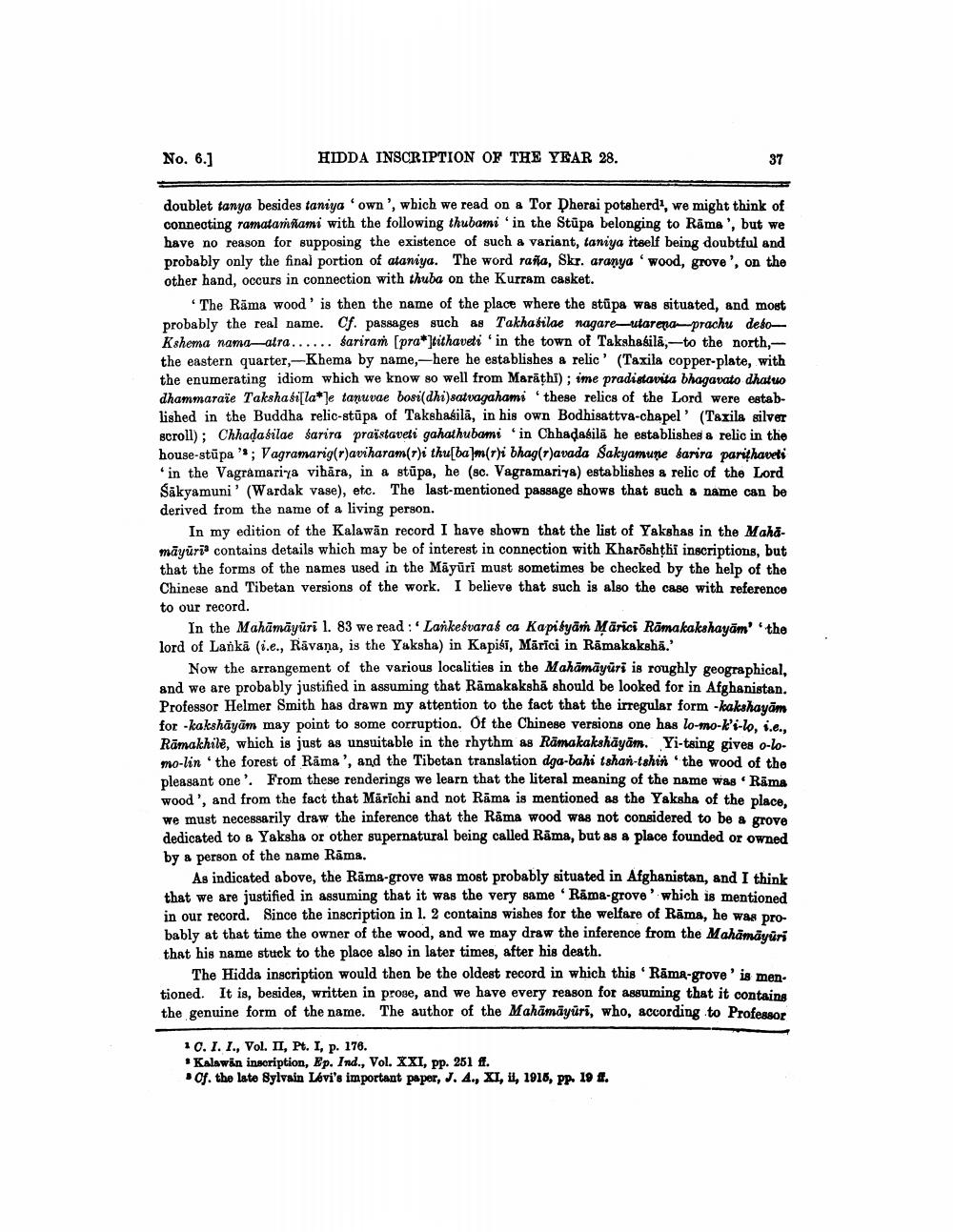________________
No. 6.]
HIDDA INSCRIPTION OF THE YEAR 28.
37
doublet tanya besides taniya own', which we read on a Tor Dherai potsherd, we might think of connecting ramatarNami with the following thubami 'in the Stūpa belonging to Räma', but we have no reason for supposing the existence of such a variant, taniya itself being doubtful and probably only the final portion of ataniya. The word raña, Skr. aranya 'wood, grove', on the other hand, occurs in connection with thuba on the Kurram casket.
The Räma wood' is then the name of the place where the stupa was situated, and most probably the real name. Cf. passages such as Takhasilae nagare-utarena prachu detoKshema nama-alra...... sariram (pra*]tithaveti 'in the town of Takshasilā, to the north, the eastern quarter,-Khema by name,-here he establishes a relic' (Taxila copper-plate, with the enumerating idiom which we know so well from Marathi); ime pradistavita bhagavato dhatuo dhammaraže Taksha si[la* Je tanuvae bosi(dhi)satvagahami 'these relics of the Lord were established in the Buddha relic-stūpa of Takshasilā, in his own Bodhisattva-chapel' (Taxila silver scroll); Chhadasilae sarira pražstaveli gahathubami in Chhadasilā he establishes & relic in the house-stūpa ' ; Vagramarig(r)aviharam(r)i thu[ba]m(r)i bhag(t)avada Sakyamune sarira parithavets
in the Vagramariya vibāra, in a stūpa, he (sc. Vagramariya) establishes & relic of the Lord Sakyamuni' (Wardak vase), etc. The last-mentioned passage shows that such a name can be derived from the name of a living person.
In my edition of the Kalawān record I have shown that the list of Yakshas in the Mahamīvüria contains details which may be of interest in connection with Kharoshthi inscriptions, but that the forms of the names used in the Māyūri must sometimes be checked by the help of the Chinese and Tibetan versions of the work. I believe that such is also the case with reference to our record.
In the Mahāmāyüri l. 83 we read : Larkesvaras ca Kapisyan Marici Rāmakakshayam' the lord of Lanka (i.e., Rävaņa, is the Yaksha) in Kapisi, Mārici in Rämakakshā.'
Now the arrangement of the various localities in the Mahāmāyuri is roughly geographical and we are probably justified in assuming that Rāmakakshā should be looked for in Afghanistan. Professor Helmer Smith has drawn my attention to the fact that the irregular form -kakshayām for -kakshāyām may point to some corruption. Of the Chinese versions one has lo-mo-k'i-lo, i.e., Rāmakhile, which is just as unsuitable in the rhythm as Rāmakakshāyām. Yi-tsing gives o-lomo-lin the forest of Rāma', and the Tibetan translation dga-bahi tshan-tshin the wood of the pleasant one'. From these renderings we learn that the literal meaning of the name was Rāma wood', and from the fact that Mārichi and not Rāma is mentioned as the Yaksha of the place. we must necessarily draw the inference that the Räma wood was not considered to be a grove dedicated to a Yaksha or other supernatural being called Rāma, but as a place founded or owned by a person of the name Rāma.
As indicated above, the Rāma-grove was most probably situated in Afghanistan, and I think that we are justified in assuming that it was the very same 'Rama-grove' which is mentioned in our record. Since the inscription in l. 2 contains wishes for the welfare of Rāma, he was probably at that time the owner of the wood, and we may draw the inference from the Mahāmāyuri that his name stuck to the place also in later times, after his death.
The Hidda inscription would then be the oldest record in which this Rāma-grove' is mentioned. It is, besides, written in proge, and we have every reason for assuming that it contains the genuine form of the name. The author of the Mahāmāyuri, who, according to Professor
10.1. I., Vol. II, Pt. I, p. 176. * Kalawan inscription, Ep. Ind., Vol. XXI, pp. 251 ff.
Of. the late Sylvain Lévi's important paper, J. 4., XI, it, 1916, pp. 19 f.




